
Original Link: https://www.anandtech.com/show/1409
AMD Sempron: A Fresh Take on Budget Computing
by Derek Wilson on July 28, 2004 12:01 AM EST- Posted in
- CPUs
Introduction
The competition in the processor market has been fierce ever since the first Athlon processors were released in the fall of 1999. In the time since then, AMD and Intel have each led and followed at different times. We have seen each company develop its strong points and grow. This release marks the next evolution for AMD in an area in which they have been very solid since even before the Athlon's release: budget computing.Today, AMD is introducing a processor to span the market between their long running Socket A platform and the first Athlon 64 platform, the Socket 754. AMD has quite a lot of experience with these two product lines, and it has been very cost-effective for them to reuse pre-existing technology in a new form at a much lower price point than current generation technology. And based heartily in that philosophy, we present the AMD Sempron line of budget processors.
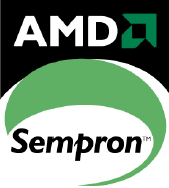
AMD's Sempron logo
The Sempron processors, as we mentioned in this AnandTech Insider article last month, is AMD's "ron" placement to the Duron processor. The name is derived from the Latin word, Semper (meaning "always"), and the tech suffix -ron (which apparently means "budget processor"). Sempron should fall at a lower performance point than equivalent rated parts from other AMD processor lines. As this processor spans two platforms, it makes sense to compare the new Sempron to both the Athlon XP line of processors and current Athlon 64 processors. And as Sempron is a budget processor, it makes sense to compare it to Intel's budget line of processors.
While we've seen multiple architectures with similar names, to some extent, in the past, consumers will have to know this time around that their Semprons from 2800+ and down work with socket A platforms, and 3100+ and up work with socket 754 or even 939 in the future. Obviously, the pertinent information will be somewhere on the box or product description, but it would be nice if AMD could make this more clear through the name of the product.
We do understand the usefulness in having a single name under which to sell, but we're not quite convinced that the benefits outweigh possible consumer confusion in an already complex marketplace.
In the following pages, we will take a look at our standard budget CPU performance tests. As these processors are designed for budget markets, special attention will be paid to price/performance throughout the article. But first, let's take a look at the silicon behind the name.
UPDATE: The pricing info we recieved was altered at launch. AMD decided to raise their prices by over 17% on the low end (the 2400+ is up to $61 from $52), and between 5% and 6% on the high end (both the 2800+ and 3200+ prices are up $6). These small dollar ammount pricing changes make a large difference on budget processors and impact price/performance analysis quite a bit. Had we recieved pricing information on par with AMD's current numbers, we wouldn't have been quite so enthusiastic about Sempron's price/performance advanatge over Celeron D. At this point, the only price advantage Sempron has over Celeron is the higher availability of cheaper motherboards.
On a positive note, AMD has confirmed our suspicion that the NX bit and Cool'n'Quiet features of Athlon 64 will be available in K8 versions of the Sempron (3100+ and higher). The only A64 feature disabled in Sempron is x86-64.
Two Flavors are Better than One: Socket A
First in line today is the socket A Sempron based on the K7 architecture.
Socket A Sempron 2800+
If the familiar rectangular shape of the core looks a little too familiar, that's probably for very good reason. The K7 Sempron is actually a 166MHz FSB 256KB Thoroughbred-B core.
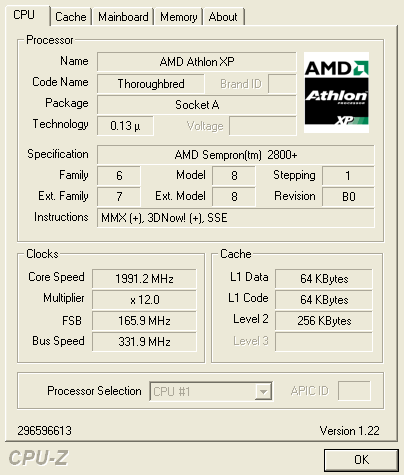
Sempron's Secret
Upon first learning this, we were a little worried that we would see overlapping parts where new Semprons would actually be old Athlon XPs. Fortunately, this is not the case.
The slowest Athlon XP 166MHz FSB Thoroughbred-B was the 2600+ with a 12.5 multiplier (2.083GHz core clock). The highest K7 Sempron clock speed is 2GHz with a 12 multiplier.
What this does mean is that higher model numbered Semprons will be slower than "equivalent" Athlon XP processors. This does make a little bit of sense in that Sempron denotes a budget processor, which will be slower than the mainstream line. This is the same type of thing that we see when looking at a 2.8 GHz Pentium 4 versus a 2.8GHz Celeron. They have the same "speed", but different performance.
In our opinion, this is a problem with marketing by clock speed, and we are disappointed to see AMD recreating a problem with artificial model numbers. So now, we have 4 different 2800+ CPUs (AXP Barton, AXP Tbred, Sempron Tbred, A64 Newcastle) and really no reason why this situation should have to exist. Hopefully, future model numbering plans will be better able to handle situations such as this.
Two Flavors are Better than One: Socket 754
Next in line: the K8 version of Sempron. In these processors, we have a little more with which to differentiate the new processors from the current generation.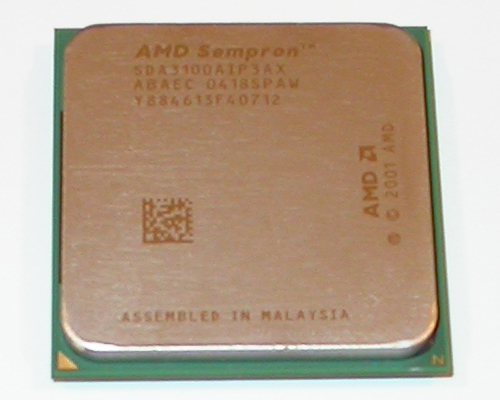
Socket 754 Sempron 3100+
Not that we can see much with the heat spreader on there, but this processor is more in the tradition of budget processors, as it is based on current Athlon 64 technology with half the cache. Specifically, the Sempron 3100+ has the same size L2 cache as the Tbred Sempron: 256KB. So, AMD started out with a 1MB L2 cache derived from the Opteron, moved to a 512KB cache, and has finally dropped down to 256KB for its budget line of K8 processors.

Socket 754 Sempron 3100+
The other very interesting and pertinent bit of information is that the K8 Sempron does not support x86-64 extensions.
While this may seem like a downside at first, this will actually help out AMD. The K8 Sempron, if cache size doesn't hurt performance too much, will give AMD the ability to offer its current generation of performance to consumers at a lower price point. The performance difference between K7 and K8 architectures on a clock for clock basis is not insignificant, and bringing this to consumers at a more attractive price point is definitely not a bad thing.
Though we won't be able to test it here (we only just received samples from AMD), we will absolutely be looking into overclocking of this part. With x86-64 and half the cache disabled, we may be able to push this part pretty hard. But we'll have to save that for a future update.
Of course, again, the clock for clock comparison part is the Athlon 64 2800+ (running at 1.8GHz). With twice the cache, this part will not be outperformed by the higher rated Sempron part. Again, we feel that this just adds to the confusion in the marketplace. We have to give AMD some credit for successfully pulling off the performance rating system with their mainstream processors, and we were happy that during the Duron's run, they stuck with clocks speeds. Even though Intel's system will be tough to get a hold of for a little while, it's a much more elegant solution to the problem of selling chips based on clock speed than a performance rating meant to reflect clock speed of a theoretical processor.
Pricing, Roadmap and Model Information
This is where things get interesting in the budget market. We'll start off with the AMD to Intel comparison, and then we'll move on to the interesting part.From our RealTime Pricing engine, Celeron's show up at NewEgg for the following prices:
Intel Celeron D 335: $127
Intel Celeron D 330: $97
Intel Celeron D 325: $88
As the Sempron isn't on the market yet, we have to go on pricing from AMD in orders of 1000 units. The line-up on these processors is as follows:
AMD Sempron 3100+: $120
AMD Sempron 2800+: $103
AMD Sempron 2600+: $79
AMD Sempron 2500+: $69
AMD Sempron 2400+: $52
AMD Sempron 2300+: $45
AMD Sempron 2200+: $39
So, what we have here is just about price parity among the top two budget processors from AMD and Intel. Again, we don't have any "real" retail numbers on Sempron yet, but these should be very close to prices at which these processors hit the street.
Because of the clock speeds of the K7 Sempron processors, we expect to see the Sempron 2800+ perform on par with an Athlon XP 2600+, which would put it above the new Celeron processors in most cases. And we'll revisit price/performance after we take a look at the performance tests.
The most interesting thing to note with respect to pricing is that the 166MHz FSB Tbred Athlon XP 2600+ can easily be found for between $70 and $80. That means that AMD's new budget line (except for the 3100+) loses out in price/performance to the mainstream chip on which it is based.
On the flip side, if overclocked and rebranded processors were a problem for AMD before (from the justification for their multiplier lock), how much more of a problem will it be for them to have aging cheap Tbred AXPs underclocked, rebranded as Semprons, and sold for more money? Granted, there aren't that many of those processors on the market right now, but it is some food for thought.
Here's a quick summary of Sempron's common features.
- 130nm manufacturing process
- 256KB L2 cache size
- 128KB L1 cache size
We've complained about the model number rating system every chance we have thus far, but to be fair, AMD has a lot of ground to make up against Intel, and they need every advantage they can get. The fact that the new aggressive model numbers step on the toes of existing AMD products is kind of a side effect. Here's why:
The new performance rating system is independent of any previous rating system and based solely on relative performance among other Sempron processors in a suite of benchmark suites. Specifically, AMD uses:
PC Magazine Business Winstone 2004
PC Magazine Content Creatoin Winstone 2004
SYSmark 2004 Office Productivity Overall
SYSmark 2004 Internet Content Creation Overall
We test part of this suite in our budget benchmarks, but we really don't have our hands on enough of the Sempron line to tell how their relative performance numbers actually indicate relative performance.
The reason why AMD focused on these suites when rating their Sempron line is that games and high performance software aren't the typical target market for budget processors. While this is perfectly acceptable, and an isolated relative scale is also acceptable, "arbitrarily" picking a single fixed point around which to scale performance numbers has led to more aggressive ratings.
Of course, if a consumer or a company is looking at building a lot of budget systems, they are going to look at equivalent price points and equivalent "performance" (by that, I mean megahertz or performance rating). The problem is that whether or not AMD wants to do things "right", they still have to sell product to the consumer. With a Sempron 2800+ cheaper than an Intel Celeron 335 (2.8GHz), people who don't understand that numbers don't mean quality will pick the cheaper part (unless they are brainwashed by the Intel brand name). People who know what's going on will understand that the Sempron 2800+ is higher performing than the Celeron 335 and will buy it if it reflects the level of performance that they desire at that price point.
The final aspect of these chips we would like to mention is power dissipation. All of the new Sempron line are designed to maximally dissipate 62W of power. This is on par with AMDs other CPUs, and we are also hearing that we might should expect mobile versions of the Sempron to be rated at less than half the wattage of their desktop counter parts. We don't know when this line of processors will be launced at this time.
The Test
In looking at our performance comparison, we want to pay attention to 3 different things: how the new Sempron parts do in comparison to Intel's budget line, how the K7 Sempron does against Athlon XP processors, and how the K8 Sempron does against other Athlon 64 processors in 32-bit mode.We only had time to benchmark a few new numbers, so the Athlon 64 that we chose was the 2800+ with the same clock speed and twice the L2 cache.
We used the same platforms in which we tested our Celeron D comparison last month. It is useful to note that we couldn't boot the Sempron on our usual VIA K8T800 based CPU test platform. AMD indicates that there shouldn't be any problems with the new chip booting in current boards, but that some manufacturers are working on BIOS updates that will fix this problem that we had. So this time around, we used a Gigabyte nForce3 250 board.
| Performance Test Configuration | |
| Processor(s): | AMD Sempron 2800+ (Socket A) AMD Sempron 3100+ (Socket 754) AMD Athlon 64 2800+ Intel Celeron D 335 (2.8GHz) Intel Celeron D 330 (2.66GHz) Intel Celeron D 325 (2.53GHz) Intel Celeron 2.6GHz Intel Celeron 2.0GHz AMD Athlon XP 2600+ AMD Athlon XP 2500+ AMD Athlon XP 2400+ AMD Athlon XP 2200+ AMD Athlon XP 1700+ AMD Duron 1.6GHz |
| RAM: | 2 x 256MB DDR400 @ 2:3:3:6 |
| Hard Drive(s): | 2 x Western Digital Special Edition 80GB |
| Chipset Drivers: | Intel Chipset Driver 5.00.1009 ForceWare 3.13 nForce Driver |
| Video Card(s): | ATI Radeon 9800 Pro 256 |
| Video Drivers: | ATI Catalyst 3.9 |
| Operating System(s): | Windows XP Professional SP1 |
| Motherboards: | ASUS A7N8X (Socket A) Gigabyte K8 Triton (Socket 754) ABit IS7 (Intel 865) |
Thanks to our new and improved graphing engine, our CPU articles will be a little easier to read with green for AMD, blue for Intel, and orange for the processors on which our review focuses. Our graphs will also be a little bit bigger to accommodate large data sets.
General Usage and Content Creation Performance
As the graph clearly shows right off the bat, the new Sempron line of processors leads Intel's latest Celeron offerings. Also, the A64 2800+ and Sempron 3100+ are performing on par in these test, as are the AXP 2600+ and Sempron 2800+ (as we thought they would).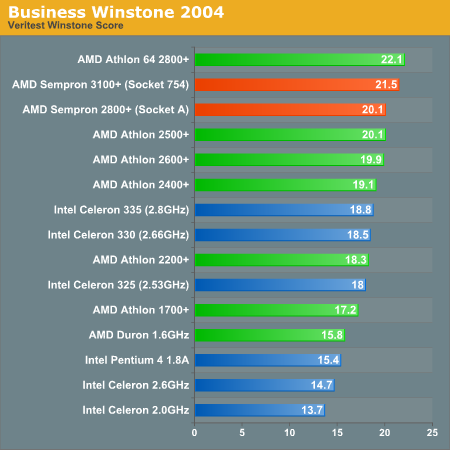

DivX 5.1 Encoding
For this test, the Sempron 2800+ leads the Athlon XP 2500+, but isn't near the 2600+ in performance. It seems in this benchmark the 83MHz makes a difference. We do need to upgrade this benchmark to DivX 5.1.1 in order to enable SSE3 on the Celeron D processors, but we didn't have time for this tight launch to rerun benchmarks on all of these CPUs.Sempron 2800+ is competitive with Celeron 330 this time around. This is one of the few benchmarks that the Sempron looses to the Celeron 335.
The difference between the Sempron 3100+ and the Athlon 64 2800+ is negligible.
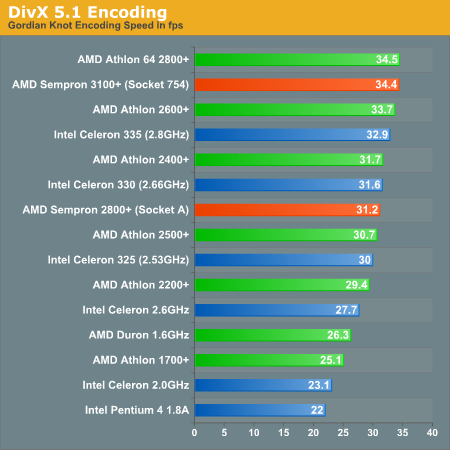
DirectX 9 Gaming Performance
These benchmarks are generally very GPU limited, so it takes a lot of extra CPU power to make a performance difference. Most of these tests show similar performance numbers.The 1.3% lead the Celeron 335 has over the Sempron 2800+ is not really significant, and the Socket 754 processors dominate this benchmark (especially considering the fact that Aquamark is very GPU limited). This is likely due to the advantages of the on die memory controller and increased memory speed of the platform.
In GunMetal, the span between the Intel Celeron 335 and the Sempron 2800+ is less than 1%, meaning that the 2 top Celerons and the Sempron 2800+ perform equivalently. The Socket 754 processors again lead in performance here with the 3100+ trailing the 2800+.
Under Halo we see a little more differentiation, with the larger cached Barton 2500+ leading the Sempron 2800+. The top AMD processors again lead the Celeron D parts in performance.
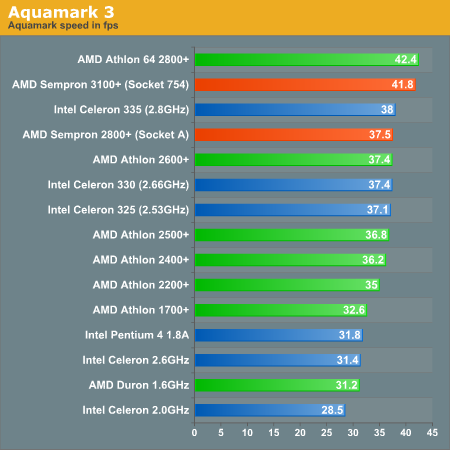
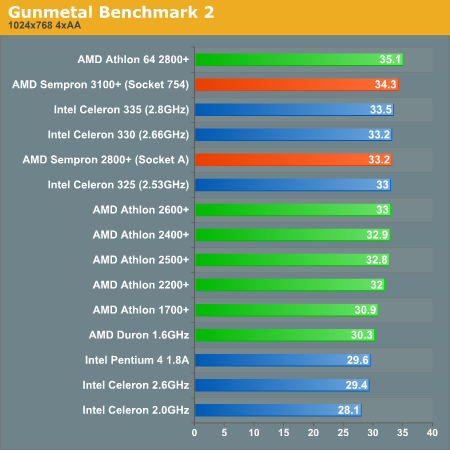
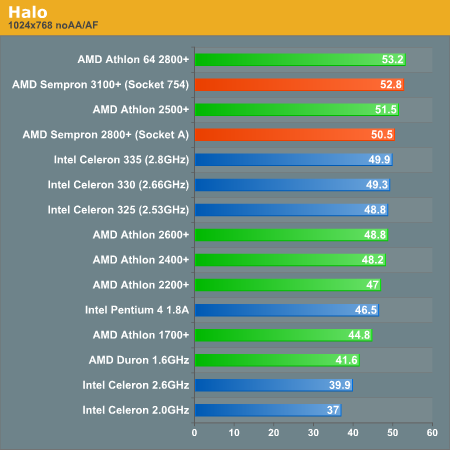
DirectX 8 Gaming Performance
In Command & Conquer, the platform advantages of 754 really shine through in this game benchmark, as this game proves to be a very system limited benchmark. The Celeron 335 leads the Sempron by about 1.7%.Unreal Tournament shows the Celeron 335 leading the Athlon XP 2600+ and the Sempron 2800+ in the flyby test (which is traditionally more graphics card limited) while the top 6 performers in the Botmatch test are AMD processors. As the Botmatch more closely resembles gameplay and is more affected by CPU, this benchmark goes to the AMD processors.
With Warcraft, the Sempron 3100+ doesn't have a competitor that can touch it from Intel. This benchmark shows the Sempron 2800+ essentially performing equivalently to the Celeron 325.
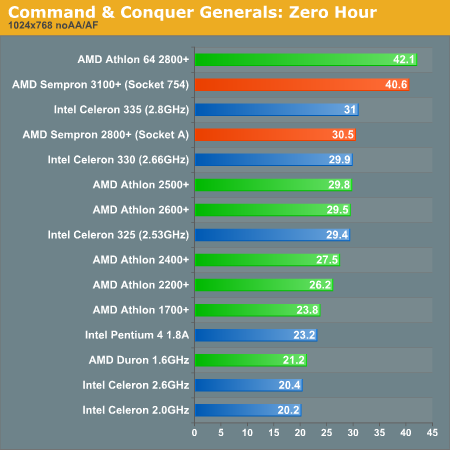
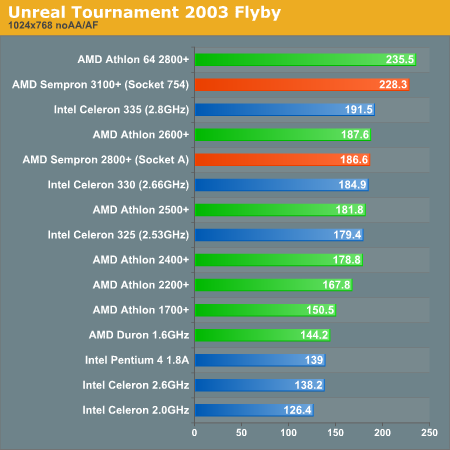
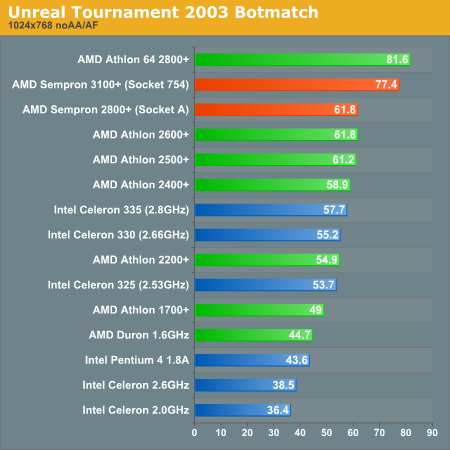
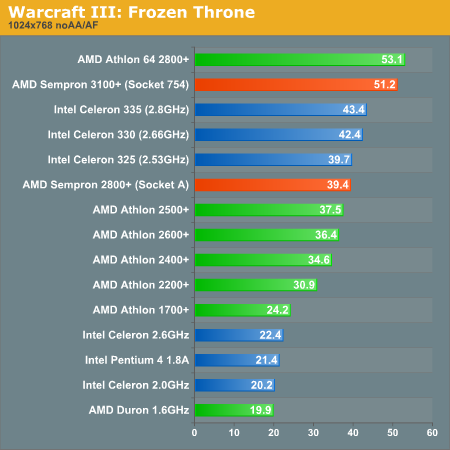
OpenGL Gaming Performance
Wolfenstein has the top 6 AMD processors leading all the Celerons once again, while Quake III Arena shows the Sempron 2800+ performing on par with the Celeon 325 once again. The K8 based processors again dominate performance, which is impressive as the Sempron 3100+ is priced essentially the same as the Celeron 335.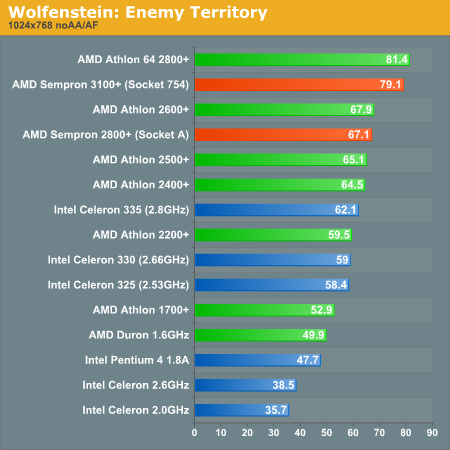
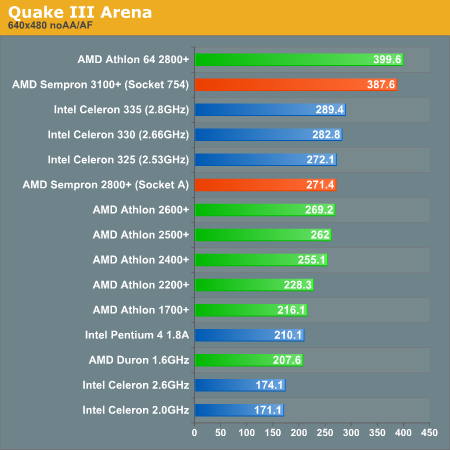
3D Rendering Performance
This test has seven different AMD processors coming in ahead of the Celeron line. This bench mark seems to favor clock speed over cache size with AMD processors, as the Barton 2500+ and Sempron 2800+ come in behind the Athlon XP 2400+.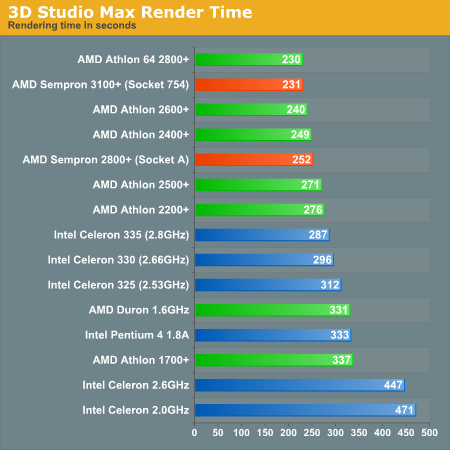
Development Workstation Performance
The Athlon 64 leads the way in performance in this category, followed by the two Semprons and the AXP 2600+. Of course, source compilation has always been a strong point for AMD, and this is just more solid performance.
Price/Performance Analysis
In comparing the price/performance data between similarly priced Celerons and Semprons, we can see that the Semprons take down the Intel platform with ease. In most benchmarks, the Sempron processors outperform the Celeron 335, and since both flavors are cheaper than the slower Celeron, price/performance is obviously in favor of AMD here. This isn't even a contest.And we can take it even further and look at how much it would cost to build a Celeron system and a Sempron system. The common components between our systems are: 512MB DDR 400 ($90), Radeon 9800 Pro 256 ($250), 80GB WD harddrive ($60). We found some really cheap cases and power supplies for less than $30. All this brings our base total to $430.
To round out our computers, the Sempron system would have a midrange nForce2 board ($50) and a Sempron 2800+ ($103).
Total Sempron System cost: $583
For the Celeron system, we would need an 856PE board ($70) and a Celeron 335 ($127).
Total Celeron System cost: $627
If we bought a Celeron system, we would be getting lower performance for 7.5% more money. This percentage would be even higher if we didn't test with such an expensive video card. Of course, we can't really make statements about system performance with lower end video cards when it comes to games. Business applications, however, are much less affected by video card choice. We could go with integrated graphics or even a $60 video card. We would spend less than $400 on a Sempron system, saving 10% over a Celeron 335 system.
Or we could look at it from another perspective. Rather than building a cheaper Sempron 2800+ system, we could build a Sempron 3100+ system and get a huge performance leap at the same price point. Maybe we've run the "Sempron is a better value than Celeron" into the ground, but the numbers just don't lie.
Moving on to the next comparison, the very low priced 166MHz Tbred Athlon XP 2600+ (which has a sightly higher clock speed than the Sempron 2800+) serves to beat the newest AMD budget chip at its own game, posting better price/performance numbers in our tests. Well, it's really that they post just about the same performance numers in every test, and that the Sempron costs at least $20 more (which, at these prices, is at least 25% more).
Though the Athlon 64 2800+ led just about all of the benchmarks, its higher price makes the Sempron a better value if you don't need the extra little bit of oomph. The winstone benchmarks tell us that average business users won't see an impact from cutting out half of their cache and going with Sempron, and the small performance hit that we see shows up mostly in gaming and source compilation.
Of course, this price/performance data doesn't take into consideration the value added to the Athlon 64 2800+ via x86-64 support. If this is a feature that the user wants, the extra $25 or so won't be a deal breaker, and the slight performance advantage will be an added bonus.
In the end, feature set is the only driving force between which processor to pick when it comes to Sempron 3100+ and Athlon 64 2800+, as performance isn't a large factor in the equation.
So who's the price performance leader here? That would be the inexpensive Athlon XP chips. But the star of the show is really the K8 Sempron, which knocks about $30 off the price of the 2800+ to deliver performance that is right on par with the more expensive chip.
Final Words
Sempron, at a glance, surpasses its goal to be a powerful budget processor. Cheaper than the current fastest Intel Celeron, both flavors of Sempron that we tested here outperform the competition in almost every test.We have long awaited the arrival of a budget chip based on the K8 architecture, and now we have one that nearly matches the performance of similarly clocked Athlon 64 chips. As clock speed ramps on Sempron and x86-64 becomes a bigger deal, we may see some separation in the ranks, but, until then, the Sempron 3100+ is a solid choice for anyone looking for a budget AMD setup with better performance and upgrade-ability than the Socket A platform.
The K7 Sempron, however, is a bit of an enigma. As time goes on and the Tbred Athlon XP processors on which Socket A Semprons are based become totally unavailable, we will see the value of Sempron rise. It just doesn't make sense to buy any of these Sempron processors when equivalent or better performing Athlon XP processors can be had for a lower price. It seems clear that Socket A Sempron will eventually be targeted at the extreme budget line of computing with the Sempron 2200+ clocked at 1.5GHz and priced about where we can find 1.2GHz Duron processors. We are actually looking forward to testing some extreme budget systems based on these processors. Performance (especially memory intensive performance) should actually look much better than Durons or early Athlons at the same speed with 4 times the L2 cache and a 333MHz FSB.
The only thing that we found really distasteful was the performance rating of these chips. When marketing with clock speeds, chip makers can't avoid the problem of higher clocked budget chips misleading the not-so-savvy buyer, but when creating an independent rating system, care should be taken to look out for the buyer. As complicated as Intel's rating system is, we find it more desirable when considering issues such as these. We do understand if AMD still feels that they need to beef up their appearance to Joe Average, but we don't have to like it.
We do also wish that there was a way to tell from the name of the processor if it is a Socket A, Socket 754, or (eventually) Socket 939 Sempron. Currently, if a consumer doesn't already know, the only way to tell is to look it up.
What's the bottom line? If you don't want x86-64, but you want the performance and motherboard selection of a K8, the Sempron 3100+ is a very nice choice. At this time, we'll have to reserve judgment on the Socket A Sempron until its cheaper siblings arrive in our labs. For now, the Sempron 2800+ is not a choice that we recommend anyone to make while the Tbred AXP 2600+ is available. The Sempron 2200+ paired with a very barebones board will help bring extraordinarily cheap computing to anyone who wants it, and we look forward to seeing how much of an improvement it is to the current Duron and Athlon offerings at the 1.5GHz clock speed.







